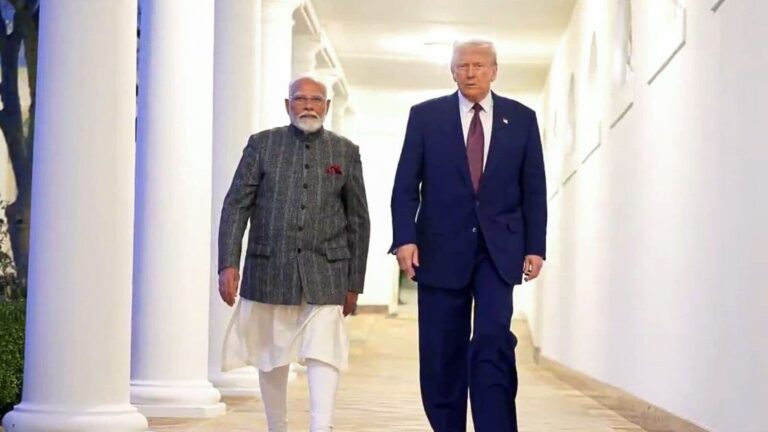India-US trade deal: While the trade deal with the US remains elusive for India, US President Donald Trump has fired a fresh salvo, warning of possible higher tariffs ahead of the August 1 deadline.
Trump said that India may be hit with a tariff rate of 20% to 25%, while cautioning that the final levy still hadn’t been finalised, according to a Bloomberg report.
Many large economies like Japan and the European Union have already signed trade agreements with the US. And a rate of 20% or higher would come as a disappointment for India, which had been seeking a better deal than the 19% that Trump offered Indonesia and the Philippines.
India and the US have held five rounds of talks so far, and a trade team from Washington is expected to visit New Delhi by mid-August, the Bloomberg report added. Meanwhile, an interim deal ahead of the August 1 deadline seems unlikely.
Trump has also threatened “secondary tariffs” on India, China and other buyers of Russian oil if President Vladimir Putin doesn’t end hostilities with Ukraine.
What’s stalling the India-US trade deal?
India is unwilling to allow the US to export genetically modified crops to the country, and is unwilling to open its dairy and automobile sectors, according to multiple reports, which is causing a major roadblock. For India, agriculture and dairy aren’t just trade sectors; they are the backbone of rural livelihoods, impacting over 700 million people.
Meanwhile, the US is pushing hard for access to India’s high-tariff markets, especially in the agri and digital sectors, while raising tariffs on Indian steel, aluminium, and auto exports. This asymmetry has stalled progress, said Sankhanath Bandyopadhyay, Economist at Infomerics Valuation and Ratings.
Trump threatens 20-25% tariff: Market may see knee-jerk impact
According to Ajit Mishra of Religare Broking, Trump’s threats are unlikely to materialise. “It seems like a statement to expedite this process because, apparently, American counterparts are going to visit India and look for further negotiations.”
But having said that, in case of any higher tariffs, there could be a knee-jerk reaction initially because the market is anyway not discounting anything extremely positive from the deal front, Mishra added. However, markets would not react very strongly as they are more focused on domestic factors like earnings, he said.
Harshal Dasani, Business Head, INVasset PMS, also believes that amid ongoing deglobalization and tariff realignments, this rhetoric could weigh on sentiment toward Indian exporters — but the market’s reaction will be sector-specific, not systemic.
Sectors which are export-heavy, such as IT, pharmaceuticals, and textiles, are likely to bear the brunt of the impact, potentially facing sharp corrections, opined Om Ghawalkar, Market Analyst, Share.Market.
How to manage your portfolio amid tariff uncertainty?
Against this backdrop, analysts advised investors with a short-term view to exercise caution.
“The lack of clarity around potential policy changes is likely to drive short-term market volatility, particularly in export-oriented sectors. In this uncertain environment, adopting a defensive investment strategy may be prudent. Shifting focus toward sectors less exposed to international trade dynamics or investing in fundamentally strong large-cap stocks with limited US revenue exposure can help reduce downside risk,” advised Ghawalkar.
He also said that holding a higher cash position could provide tactical flexibility, allowing investors to act swiftly as and when developments unfold.
Meanwhile, Mishra said that for short-term investors, it’s prudent that they should keep on trading with stop losses in place, especially when it comes to the long trades in pharma packs. As for the IT pack, in case of a further decline, Mishra recommended investors treat this as an opportunity to accumulate stocks for the long term.
Long-term investors should stay put and should not feel worried about the market reaction, he added.
Commenting on the sectors investors can take exposure in, Dasani said the near-term strategy should tilt towards domestic-facing sectors like financials, capital goods, and autos, which are better insulated from trade friction.
“On the other hand, a correction in export-centric sectors—textiles, chemicals, and electronics—may create a tactical accumulation window. The long-term thesis remains solid. A delayed deal does not mean a dead one. Once resolved, the beneficiaries will likely be companies embedded in supply chain diversification, defence, and semiconductors,” he opined.
Disclaimer: This story is for educational purposes only. The views and recommendations made above are those of individual analysts or broking companies, and not of Mint. We advise investors to check with certified experts before making any investment decisions.
